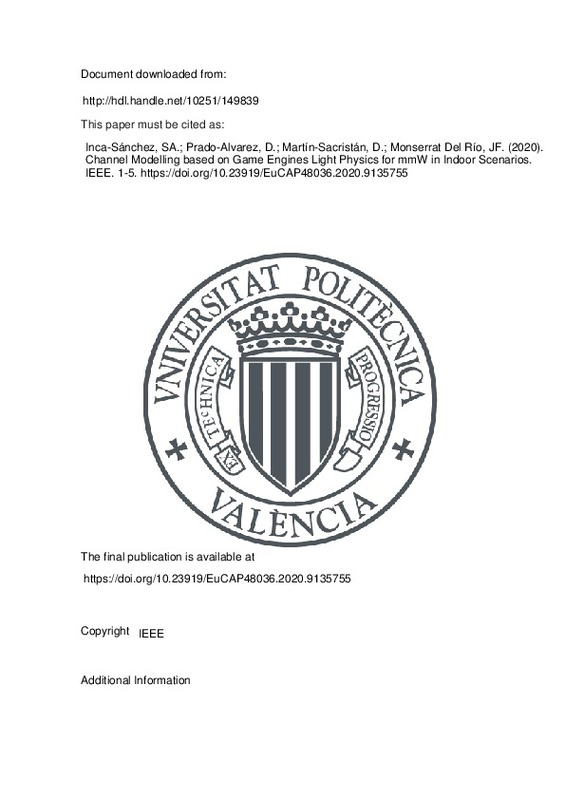JavaScript is disabled for your browser. Some features of this site may not work without it.
Buscar en RiuNet
Listar
Mi cuenta
Estadísticas
Ayuda RiuNet
Admin. UPV
Channel Modelling based on Game Engines Light Physics for mmW in Indoor Scenarios
Mostrar el registro sencillo del ítem
Ficheros en el ítem
| dc.contributor.author | Inca-Sánchez, Saúl Adrián
|
es_ES |
| dc.contributor.author | Prado-Alvarez, Danaisy
|
es_ES |
| dc.contributor.author | Martín-Sacristán, David
|
es_ES |
| dc.contributor.author | Monserrat del Río, Jose Francisco
|
es_ES |
| dc.date.accessioned | 2020-09-11T09:21:32Z | |
| dc.date.available | 2020-09-11T09:21:32Z | |
| dc.date.issued | 2020-03-20 | es_ES |
| dc.identifier.isbn | 978-88-31299-00-8 | es_ES |
| dc.identifier.uri | http://hdl.handle.net/10251/149839 | |
| dc.description.abstract | [EN] The importance of Millimeter Waves (mmW) band for the Fifth Generation (5G) of mobile and wireless communications has motivated a lot of work in mmW channel modelling. In this paper, we assess the use of the light physics modelling of a game engine to calculate the propagation losses at mmW band in an indoor scenario. With that aim, we propose a model that we refer to as Light Intensity Model (LIM), in which a detailed 3D scenario is created in a game engine, radio transmitters and receivers are replaced by light sources and detectors, and the received light intensities are translated to received radio signal power through a translation function which is the key of the model. The results obtained corroborate the validity of the assessed approach to model propagation losses in indoor scenarios | es_ES |
| dc.description.sponsorship | This work has been partially funded by MSCA Project 766231 WaveComBE. This work has also been partially performed in the framework of the H2020 project 5G-SMART co-funded by the EU. The authors would like to acknowledge the contributions of their colleagues. The views expressed are those of the authors and do not necessarily represent the project. The consortium is not liable for any use that may be made of any of the information contained therein. | es_ES |
| dc.language | Inglés | es_ES |
| dc.publisher | IEEE | es_ES |
| dc.relation.ispartof | 2020 14th European Conference on Antennas and Propagation (EuCAP) | es_ES |
| dc.rights | Reserva de todos los derechos | es_ES |
| dc.subject | Millimeter waves | es_ES |
| dc.subject | MmW | es_ES |
| dc.subject | Propagation | es_ES |
| dc.subject | Channel modelling | es_ES |
| dc.subject | Path loss | es_ES |
| dc.subject | Game engine | es_ES |
| dc.subject.classification | TEORIA DE LA SEÑAL Y COMUNICACIONES | es_ES |
| dc.title | Channel Modelling based on Game Engines Light Physics for mmW in Indoor Scenarios | es_ES |
| dc.type | Comunicación en congreso | es_ES |
| dc.type | Capítulo de libro | es_ES |
| dc.identifier.doi | 10.23919/EuCAP48036.2020.9135755 | es_ES |
| dc.relation.projectID | info:eu-repo/grantAgreement/EC/H2020/766231/EU/mmWave Communications in the Built Environments/ | es_ES |
| dc.rights.accessRights | Abierto | es_ES |
| dc.contributor.affiliation | Universitat Politècnica de València. Departamento de Comunicaciones - Departament de Comunicacions | es_ES |
| dc.contributor.affiliation | Universitat Politècnica de València. Instituto Universitario de Telecomunicación y Aplicaciones Multimedia - Institut Universitari de Telecomunicacions i Aplicacions Multimèdia | es_ES |
| dc.description.bibliographicCitation | Inca-Sánchez, SA.; Prado-Alvarez, D.; Martín-Sacristán, D.; Monserrat Del Río, JF. (2020). Channel Modelling based on Game Engines Light Physics for mmW in Indoor Scenarios. IEEE. 1-5. https://doi.org/10.23919/EuCAP48036.2020.9135755 | es_ES |
| dc.description.accrualMethod | S | es_ES |
| dc.relation.conferencename | 14th European Conference on Antennas and Propagation (EUCAP 2020) | es_ES |
| dc.relation.conferencedate | Marzo 15-20,2020 | es_ES |
| dc.relation.conferenceplace | Copenhagen, Denmark | es_ES |
| dc.relation.publisherversion | https://doi.org/10.23919/EuCAP48036.2020.9135755 | es_ES |
| dc.description.upvformatpinicio | 1 | es_ES |
| dc.description.upvformatpfin | 5 | es_ES |
| dc.type.version | info:eu-repo/semantics/publishedVersion | es_ES |
| dc.relation.pasarela | S\415589 | es_ES |







![[Cerrado]](/themes/UPV/images/candado.png)

